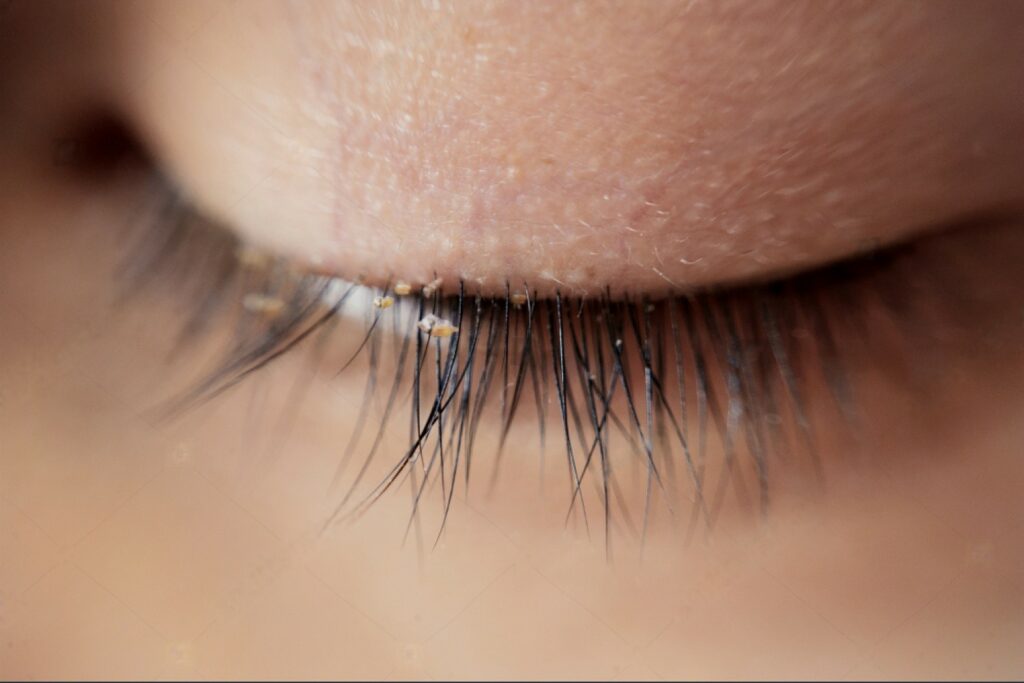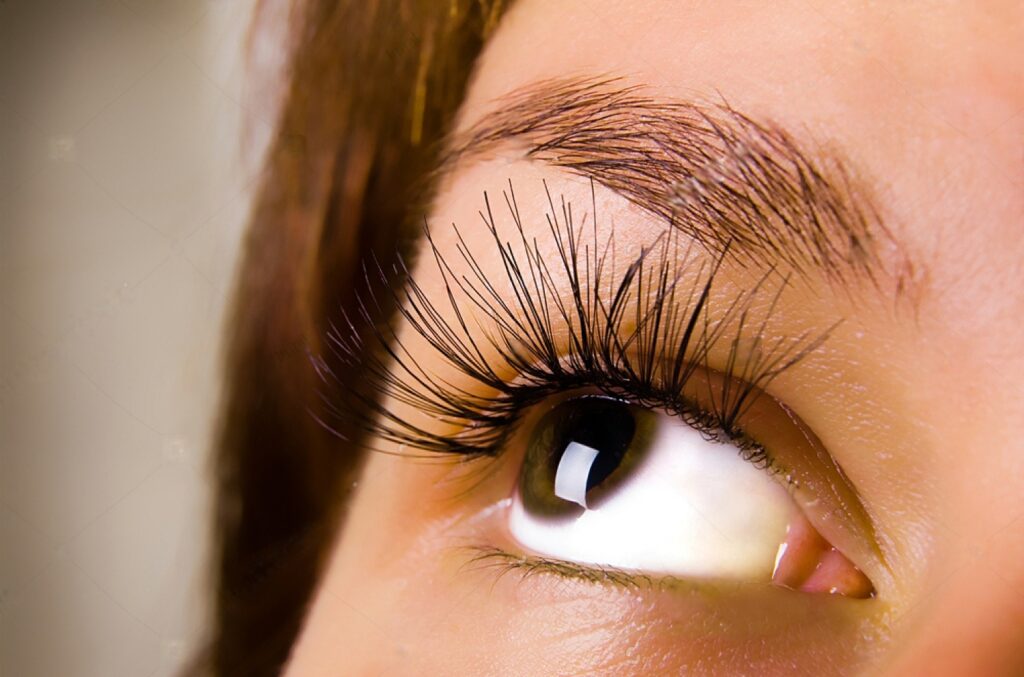Eyelash extensions have become an increasingly popular cosmetic enhancement, offering the allure of fuller, longer lashes without the need for daily mascara application. While these extensions provide a convenient and aesthetic solution for enhancing one’s appearance, the underlying risks associated with their use are often underestimated.
In a recent case, a 22-year-old woman from London experienced partial blindness in one eye after developing a severe infection. The infection was suspected to be related to improper contact lens hygiene prior to the eyelash extension procedure. However, it could also have been a result of a non-sterile environment at the salon or the technician’s practices. Such incidents highlight the potential risks associated with getting eyelash extensions, particularly when it comes to ocular health.
The Unseen Threat: Formaldehyde in Eyelash Glue
The safety of eyelash extensions hinges significantly on the adhesive used to attach the synthetic lashes to the natural ones. While many glues on the market claim to be free of harmful substances, recent studies suggest otherwise. A study by Xiong et al. (2022) conducted a thorough analysis of both consumer and professional eyelash glues using the chromotropic acid method (CAM) to detect the presence of formaldehyde—a known carcinogen and allergen. The findings were alarming: 75% of professional eyelash glues tested positive for formaldehyde, despite not listing it as an ingredient.
Formaldehyde is not only a potent irritant but also a substance with significant long-term health implications, including allergic contact dermatitis and an increased risk of cancer. The study’s results highlight the need for stricter regulation and better transparency in the cosmetic industry, particularly concerning products used in close proximity to the eyes.
Beyond Formaldehyde: Other Risks of Eyelash Extensions
1. Allergic Reactions and Infections:
The American Academy of Ophthalmology (AAO) emphasizes that improper application and hygiene can lead to complications such as allergic reactions and infections. The chemicals in the glue or the synthetic materials used in the extensions can trigger reactions ranging from mild irritation to severe swelling and pain.
Infections are another significant risk, particularly when extensions are applied in unsanitary conditions or when proper eyelid hygiene is neglected. According to the AAO’s 2024 Blepharitis Preferred Practice Pattern (PPP®), blepharitis can be exacerbated by the buildup of bacteria and debris around the base of the eyelashes, leading to chronic irritation and discomfort. Similarly, the Conjunctivitis PPP® highlights how bacterial or viral conjunctivitis can occur when pathogens are introduced to the eye, often due to poor hygiene practices, which could occur during or after the application of extensions.

2. Eyelash Mites (Demodex folliculorum):
One of the less commonly discussed but equally concerning risks associated with eyelash extensions is the potential for an increase in Demodex mites. These tiny parasites naturally inhabit the hair follicles of the eyelashes but can proliferate excessively in the oily environment created by eyelash extensions, especially when consumers avoid cleansing the area frequently to preserve the longevity of the false lashes. Reports suggest an uptick in cases of Demodex infestations among those who frequently use eyelash extensions, leading to symptoms such as itching, redness, and a gritty sensation in the eyes, often mistaken for a simple allergic reaction.
The presence of Demodex mites is particularly problematic in individuals with underlying conditions such as blepharitis, as noted in the Blepharitis PPP®. The guidelines recommend proper eyelid hygiene, including regular cleaning with tea tree oil-based products, to reduce the risk of infestation and manage Demodex populations effectively.
3. Chemical Trauma and Long-Term Effects:
The glue used in eyelash extensions is not only a potential allergen but also a source of chemical trauma to the eye. In a clinical scenario presented in Optometry Today, a patient experienced severe keratoconjunctivitis after undergoing an eyelash extension procedure. The condition, which involves inflammation of the cornea and conjunctiva, was likely triggered by volatile compounds released from the glue, resulting in significant discomfort and a risk of long-term damage to the ocular surface.
Repeated use of eyelash extensions can also lead to chronic conditions such as blepharitis. The chronic inflammation of the eyelids, coupled with the constant mechanical stress on the hair follicles, can result in permanent damage to the natural lashes, including lash loss and follicular scarring.
Clinical Considerations
In clinical practice, patients may present with ocular issues without immediately disclosing their use of eyelash extensions (they could be wearing false lashes instead, which are removable). When examining such cases, it might be useful to consider whether the patient’s symptoms could potentially be related to recent a cosmetic procedure. If a patient has eyelash extensions and is experiencing symptoms such as irritation, redness, or swelling, discussing the potential risks of continued use may be beneficial.
For instance, the presence of formaldehyde in eyelash glues, as highlighted in the aforementioned study, could be a point of discussion. Advising patients to avoid eyelash extensions in the future or to choose safer alternatives may help prevent recurrent issues. Additionally, in cases where infections or mite infestations are suspected, the guidelines from the AAO’s PPP® on blepharitis and conjunctivitis can offer valuable insights into effective management and prevention strategies.
Face Forward: Balancing Beauty and Eye Health
Eyelash extensions offer a convenient and aesthetically pleasing way to enhance one’s appearance, but they come with a range of potential risks that should not be overlooked. Being informed about these risks allows consumers to make better decisions regarding their beauty routines, ensuring that their choices also support long-term eye health.
References
- American Academy of Ophthalmology (AAO). (2018). Eyelash Extension Facts and Safety. Accessed August, 2024. Available at: https://www.aao.org/eye-health/tips-prevention/eyelash-extension-facts-safety
- Cheung AY, Choi DS, Ahmad S, et al. Conjunctivitis Preferred Practice Pattern. Ophthalmology. 2024;131(4):P134-P204. doi:10.1016/j.ophtha.2023.12.037
- Daily Mail UK. (2024). I went blind in one eye after having false lashes fitted while wearing contact lenses – I still can’t see properly 18 months on. Accessed August, 2024. Available at: https://www.dailymail.co.uk/femail/article-13353139/Glamorous-receptionist-left-BLIND-lash-extensions.html
- Idu FK, Efosa AD, Mutali M Jr. Ocular Side Effects of Eyelash Extension Use Among Female Students of the University of Benin, Benin City, Edo State, Nigeria. Cureus. 2024;16(1):e53047. Published 2024 Jan 27. doi:10.7759/cureus.53047
- Lin A, Ahmad S, Amescua G, et al. Blepharitis Preferred Practice Pattern®. Ophthalmology. 2024;131(4):P50-P86. doi:10.1016/j.ophtha.2023.12.036
- Optometry Today. (2023). Sore and swollen eyes after false eyelash appointment. Accessed August, 2024. Available at: https://www.aop.org.uk/ot/life-in-practice/practitioner-stories/2023/11/06/sore-and-swollen-eyes-after-false-eyelash-appointment
- The New York Post. (2019). Doctors warn that eyelash extensions are helping lice spread. Accessed August, 2024. Available at: https://nypost.com/2019/11/18/doctors-warn-that-eyelash-extensions-are-helping-lice-spread/
- Xiong M, Shaik JA, Hylwa S. Formaldehyde Release From Eyelash Glues: Analysis Using the Chromotropic Acid Method. Dermatitis. 2022;33(6):442-446. doi:10.1097/DER.0000000000000910
About Docquity
If you need more confidence and insights to boost careers in healthcare, expanding the network to other healthcare professionals to practice peer-to-peer learning might be the answer. One way to do it is by joining a social platform for healthcare professionals, such as Docquity.
Docquity is an AI-based state-of-the-art private & secure continual learning network of verified doctors, bringing you real-time knowledge from thousands of doctors worldwide. Today, Docquity has over 400,000 doctors spread across six countries in Asia.
Meet experts and trusted peers across Asia where you can safely discuss clinical cases, get up-to-date insights from webinars and research journals, and earn CME/CPD credits through certified courses from Docquity Academy. All with the ease of a mobile app available on Android & iOS platforms!







